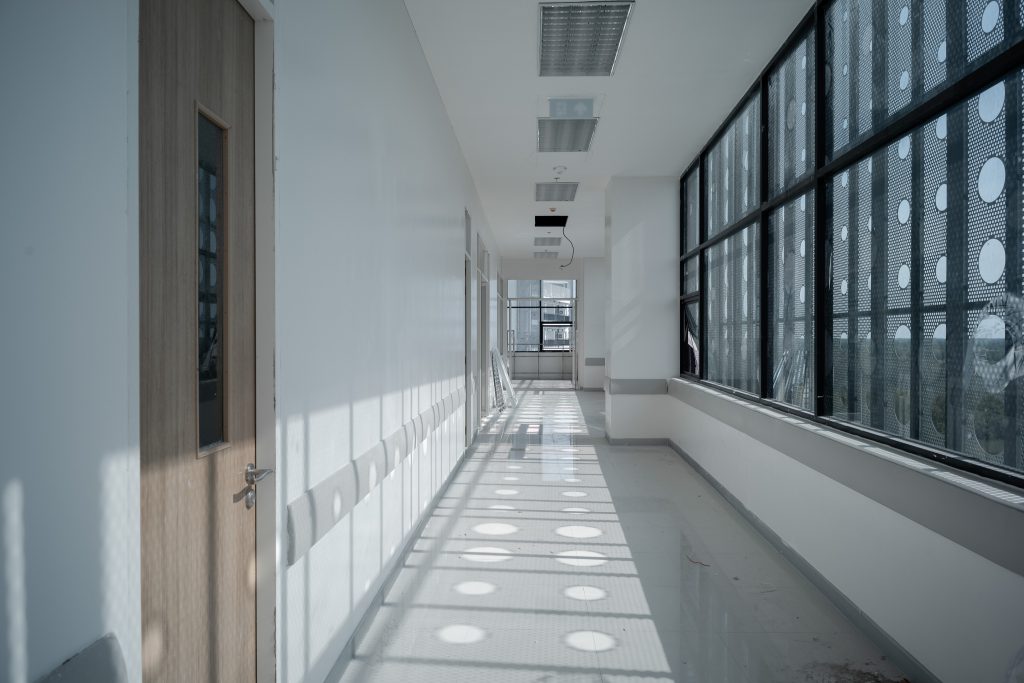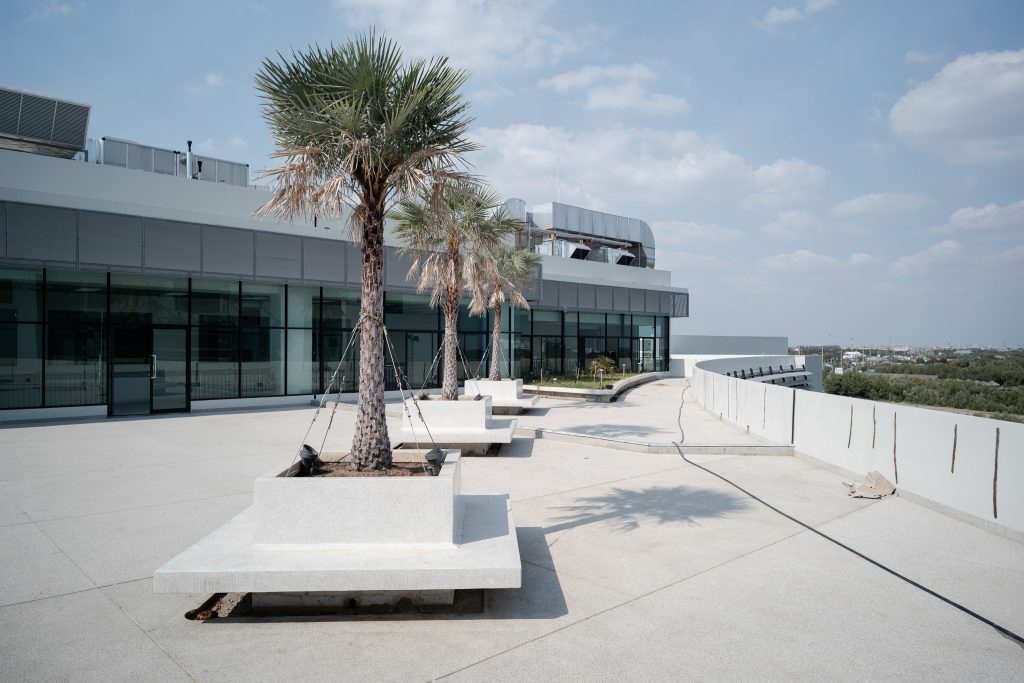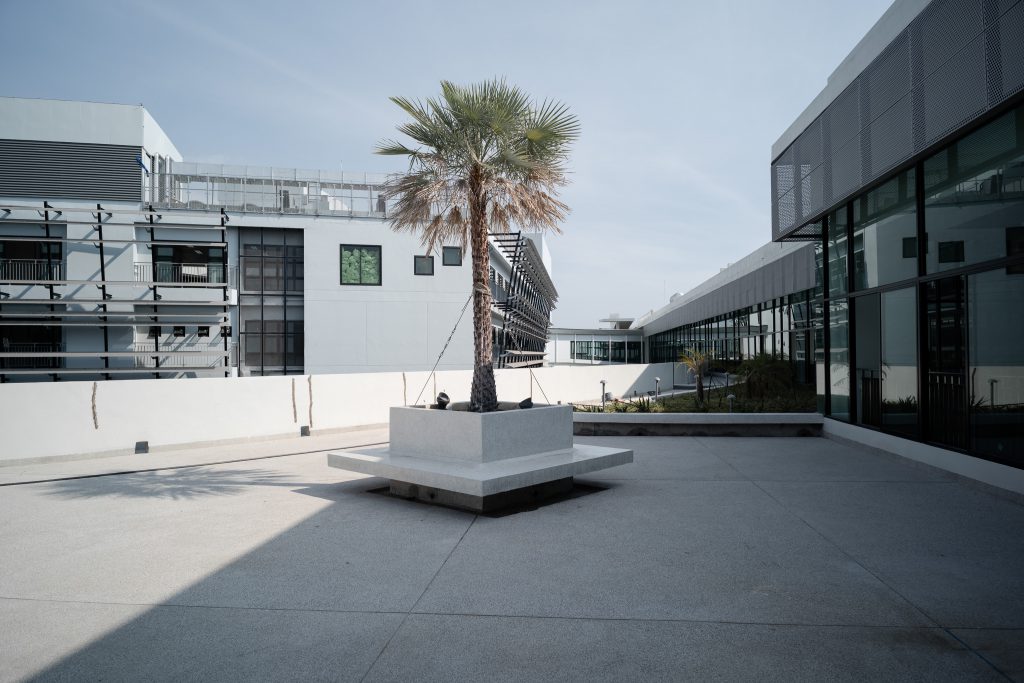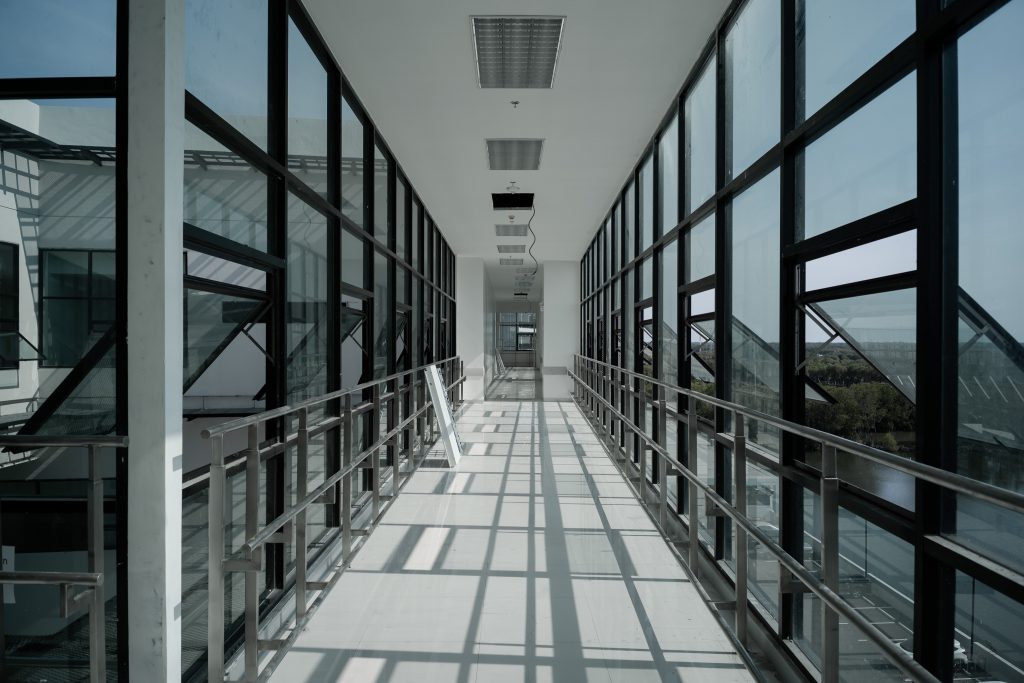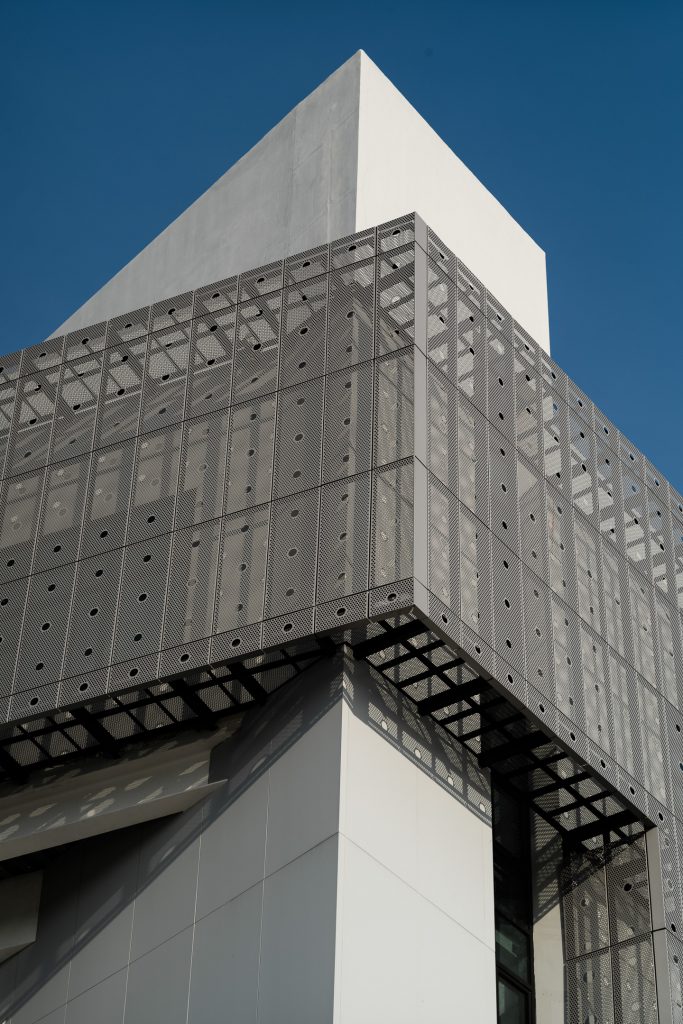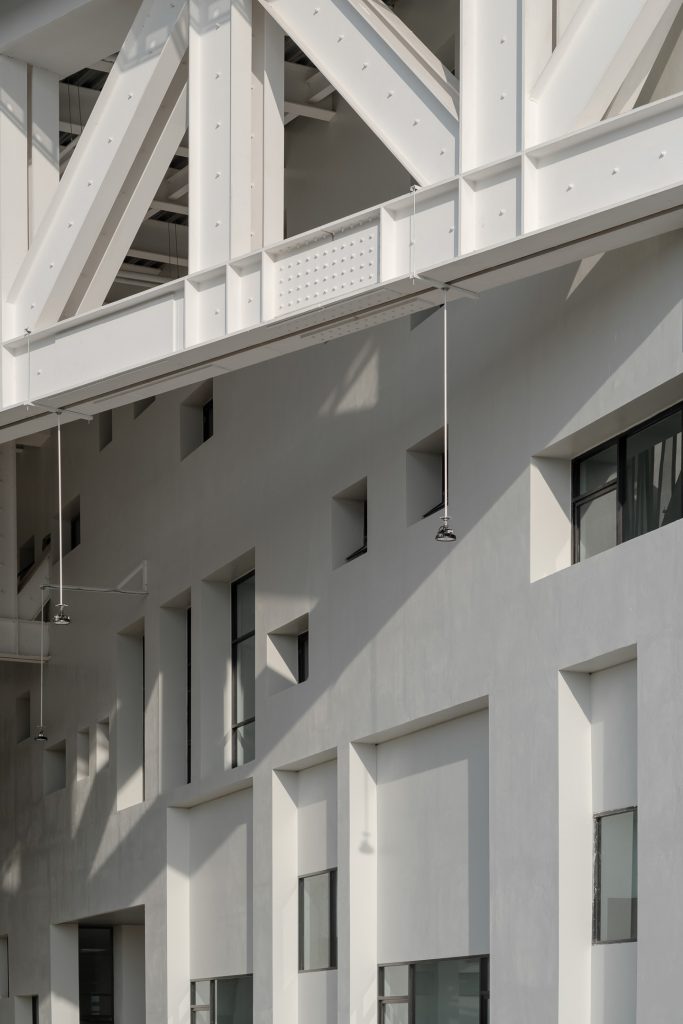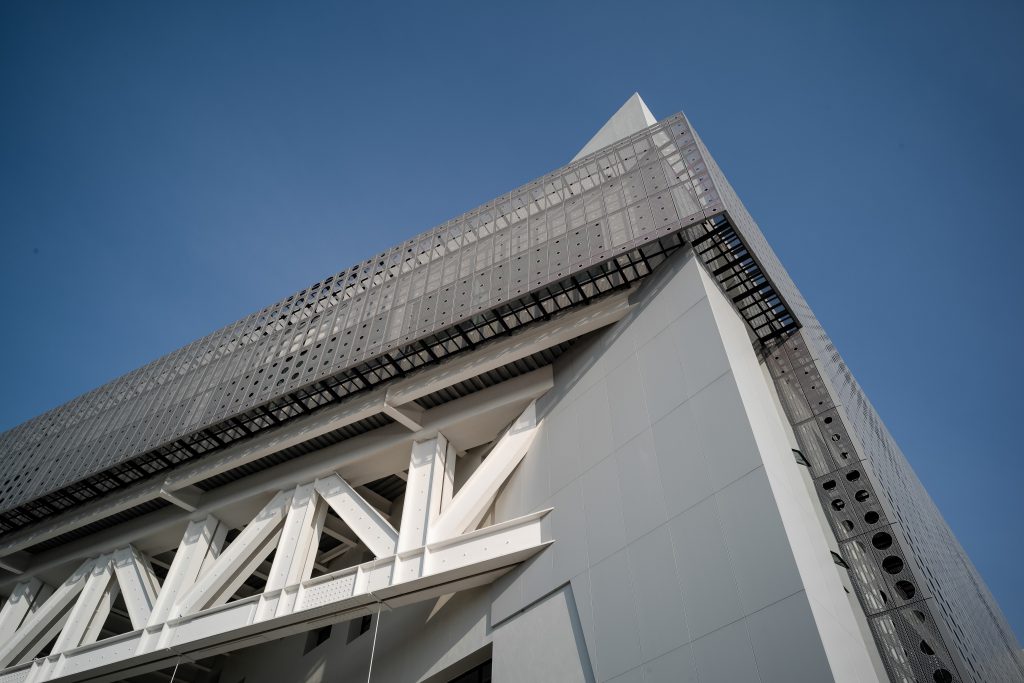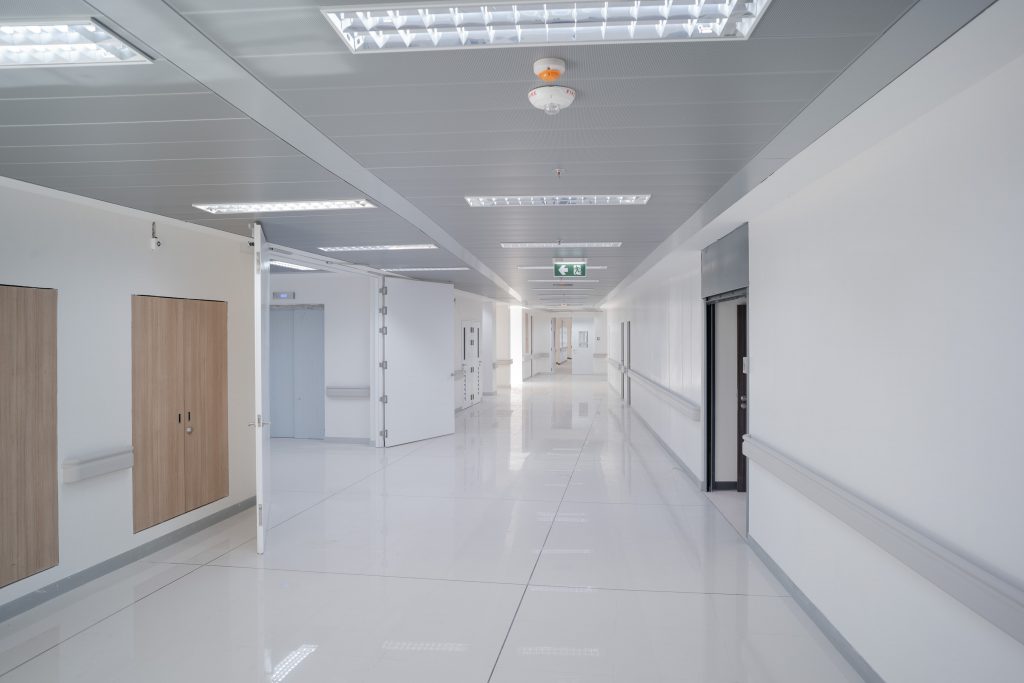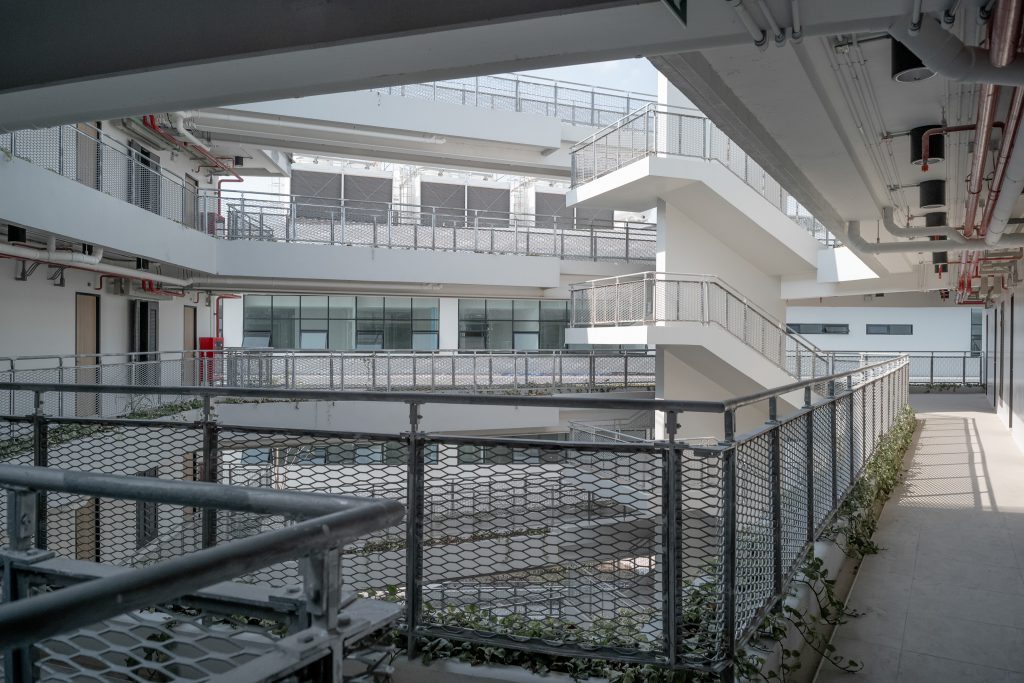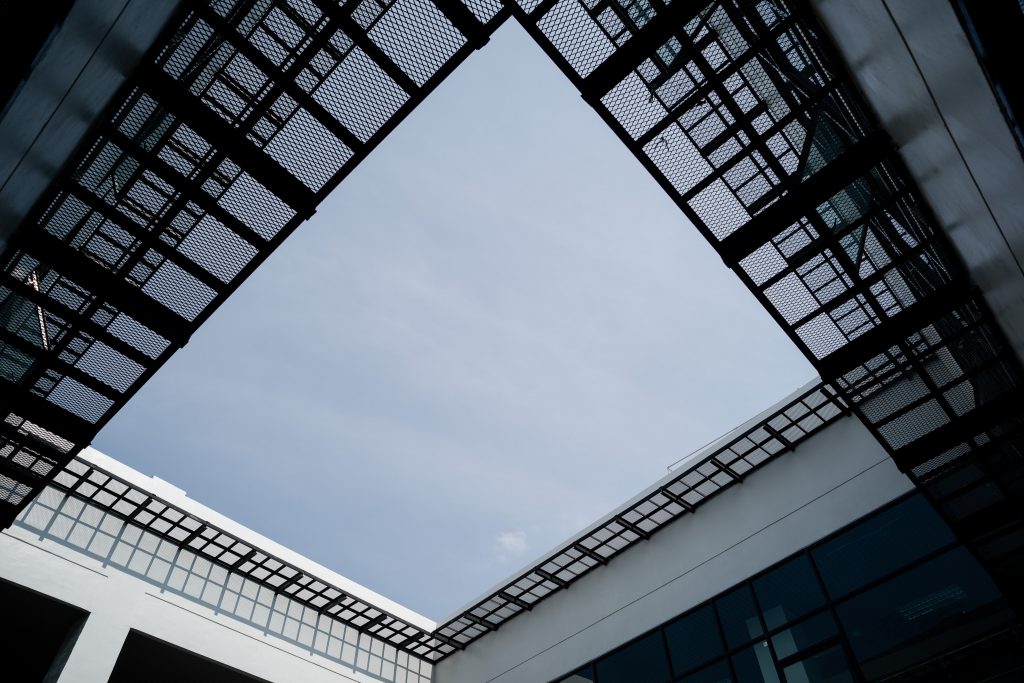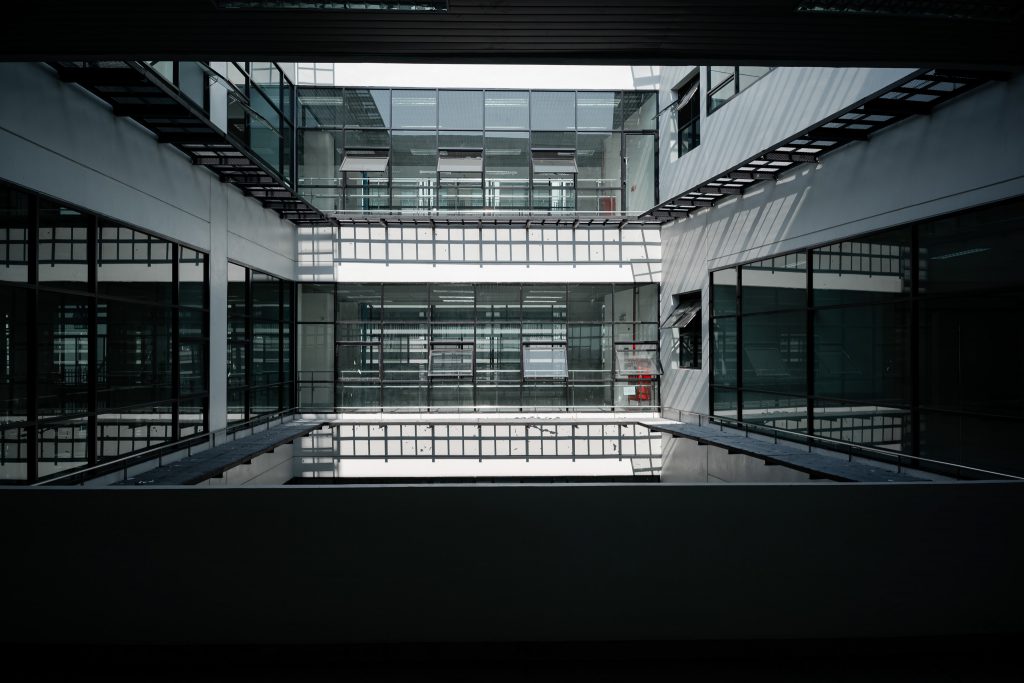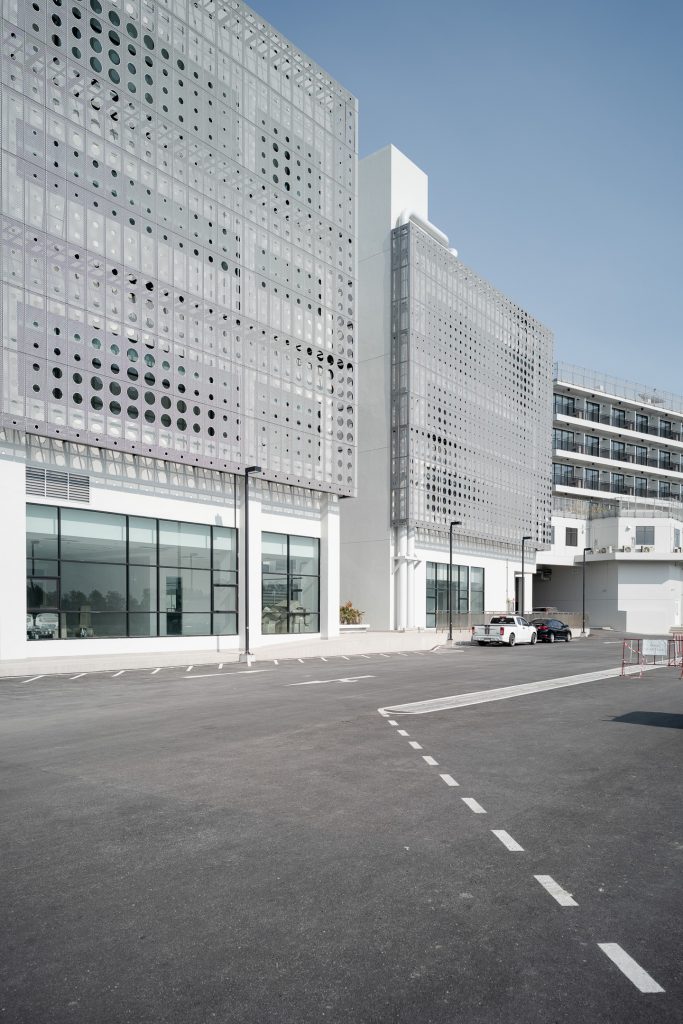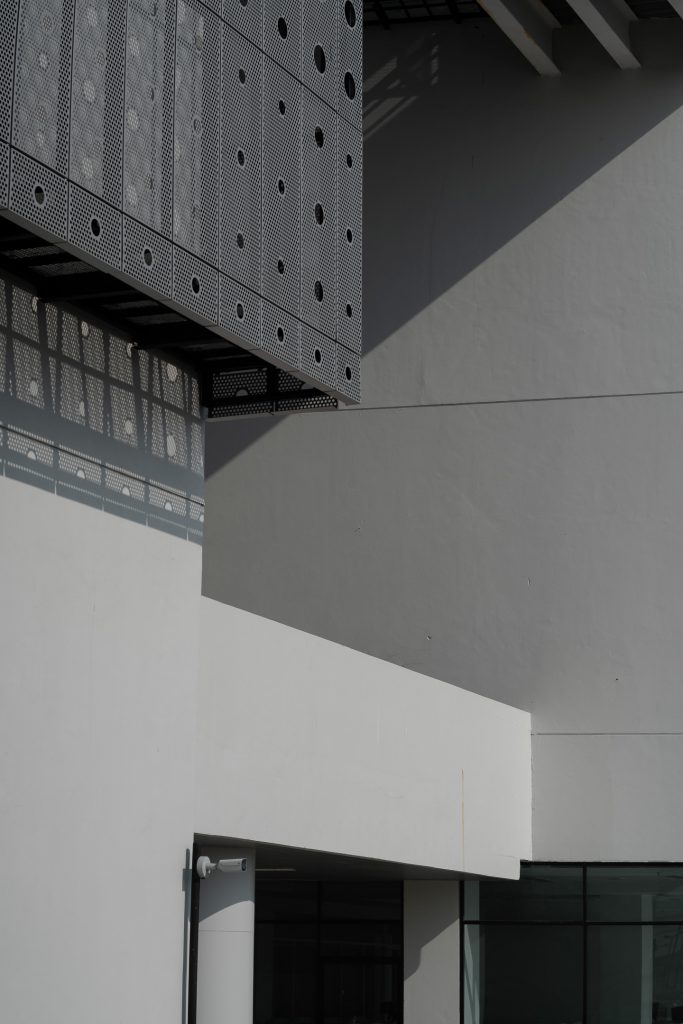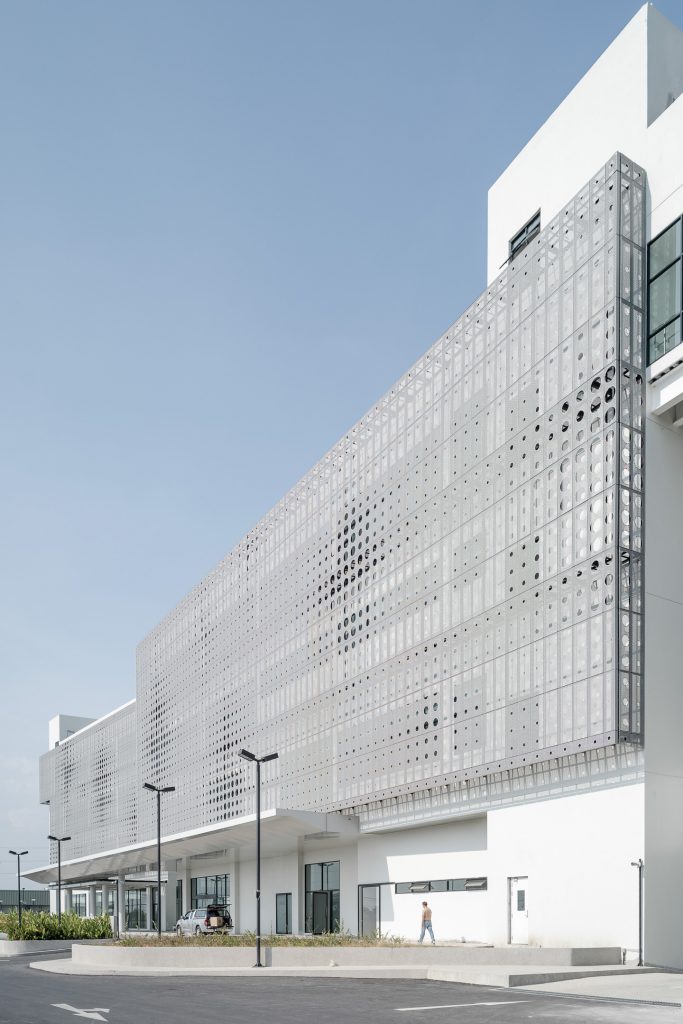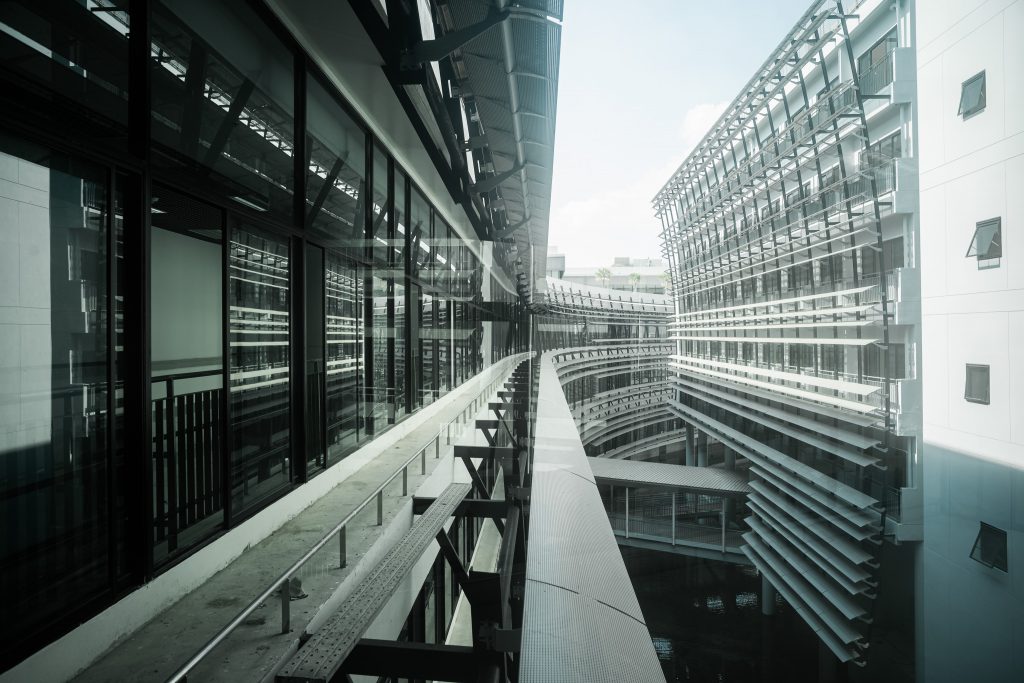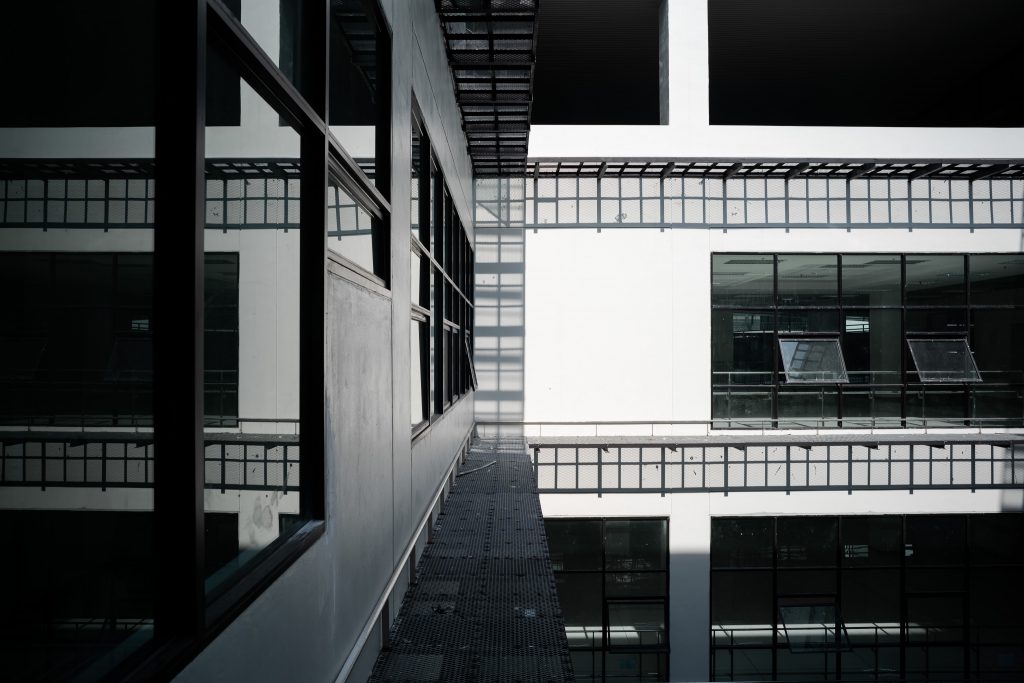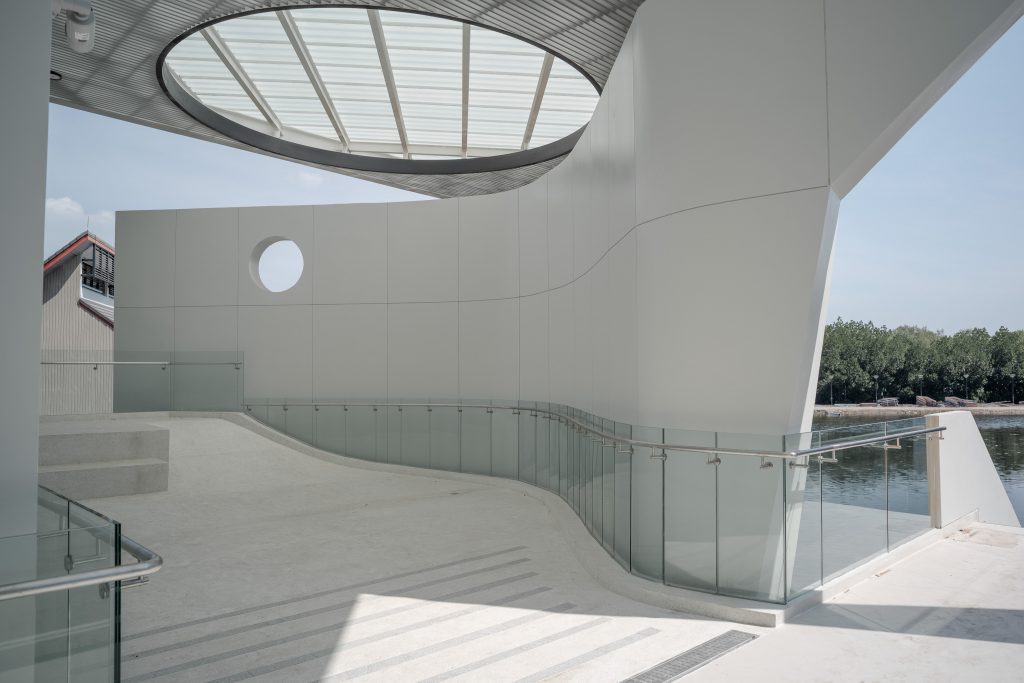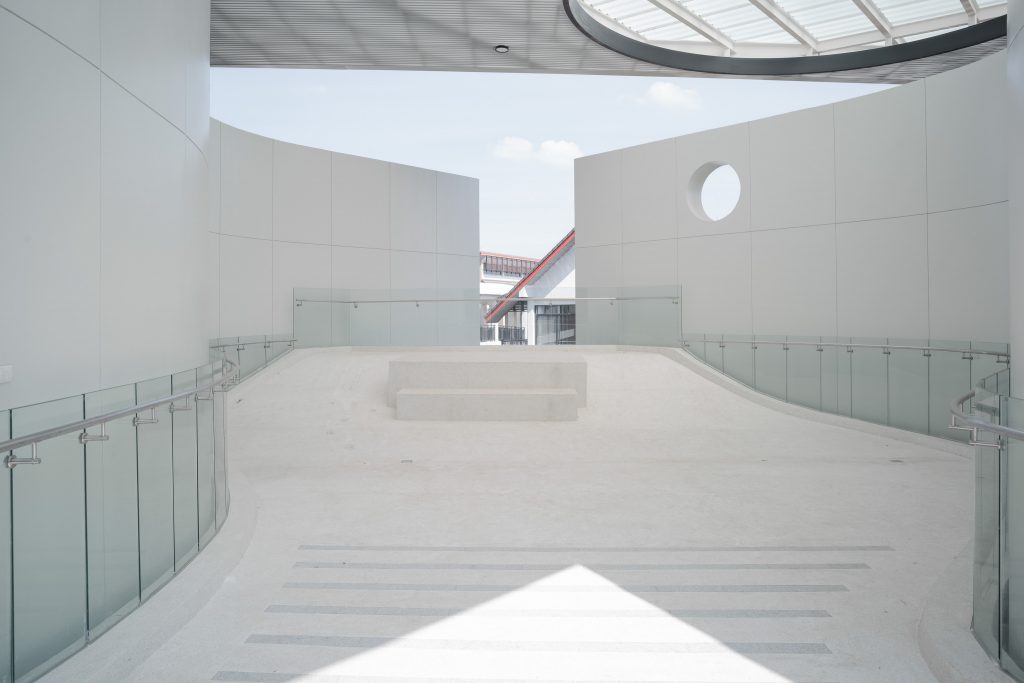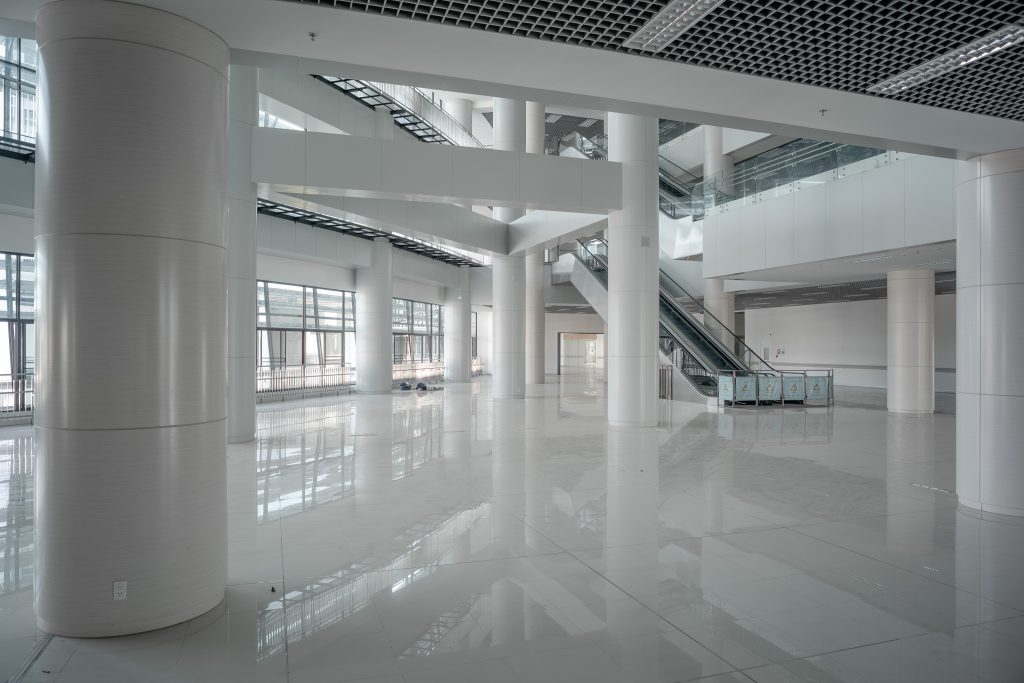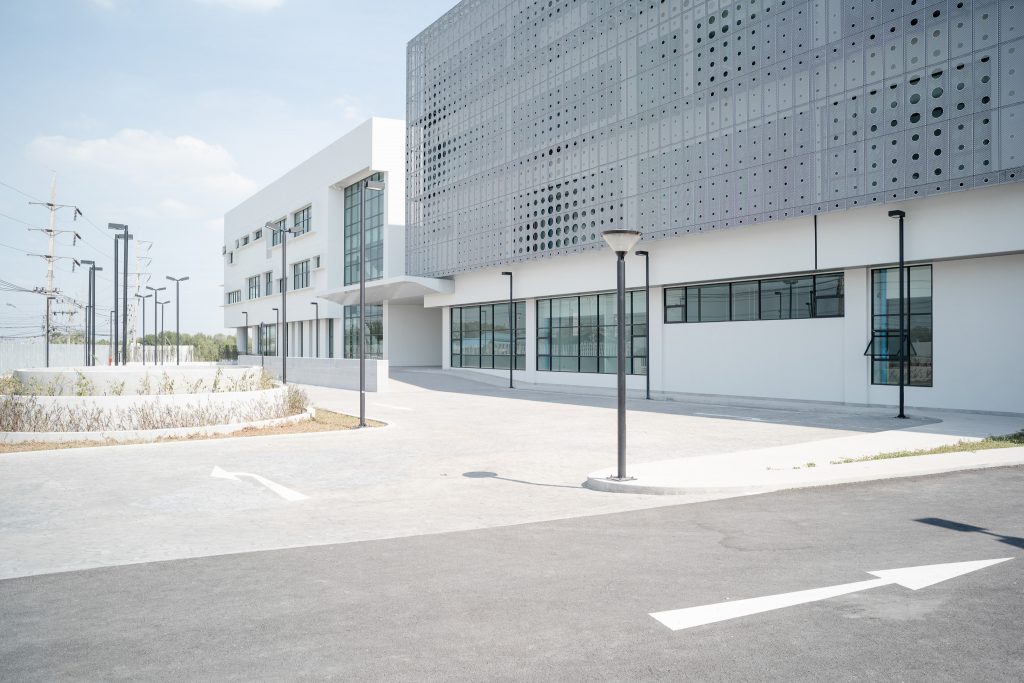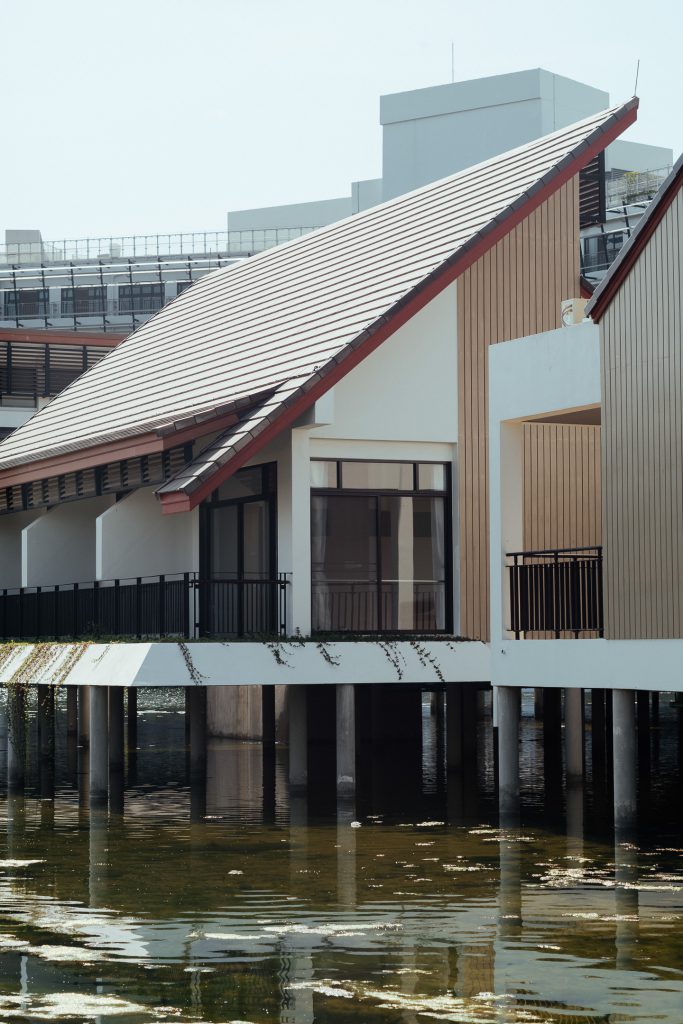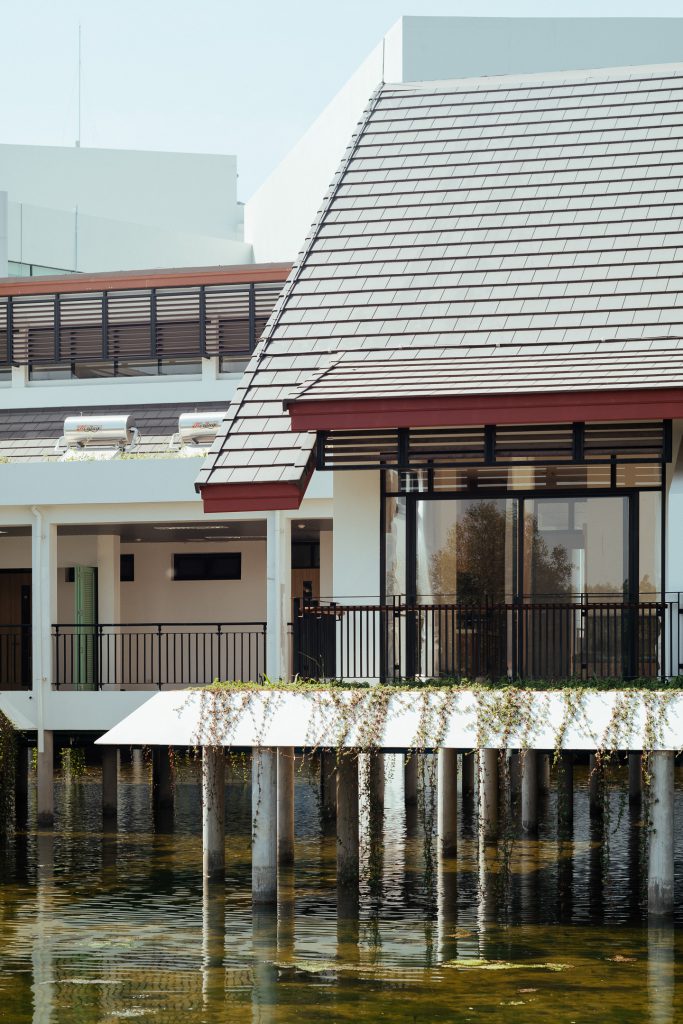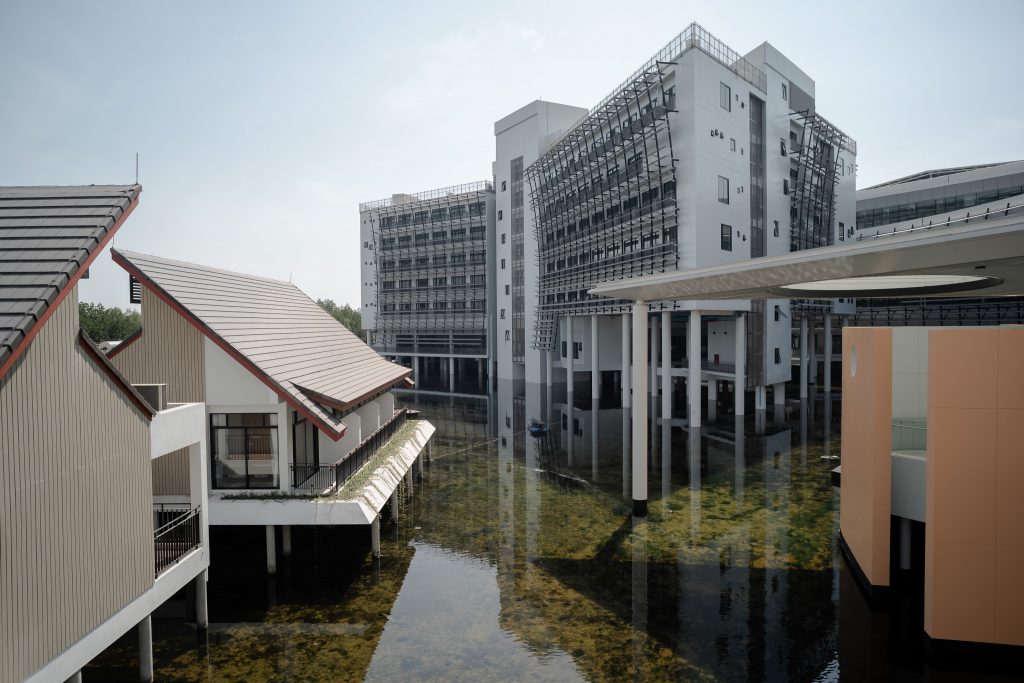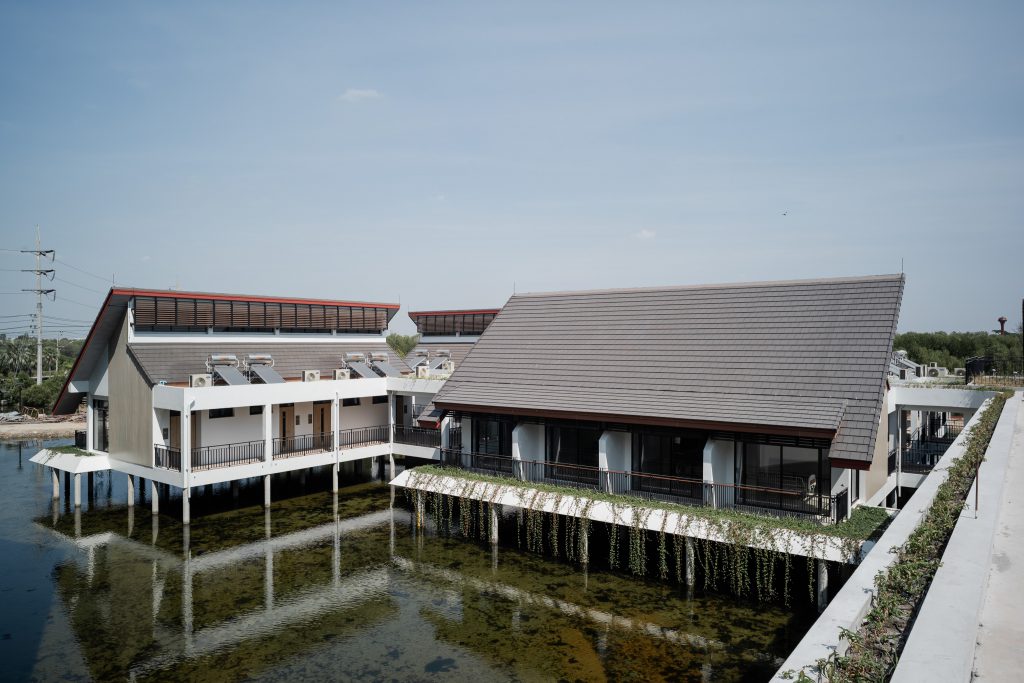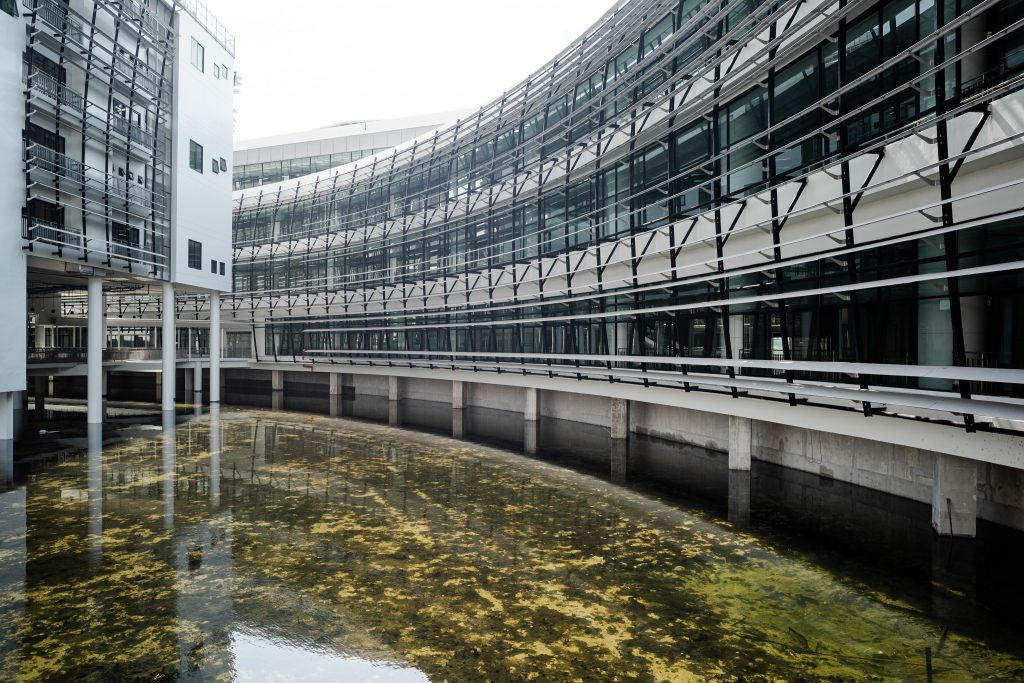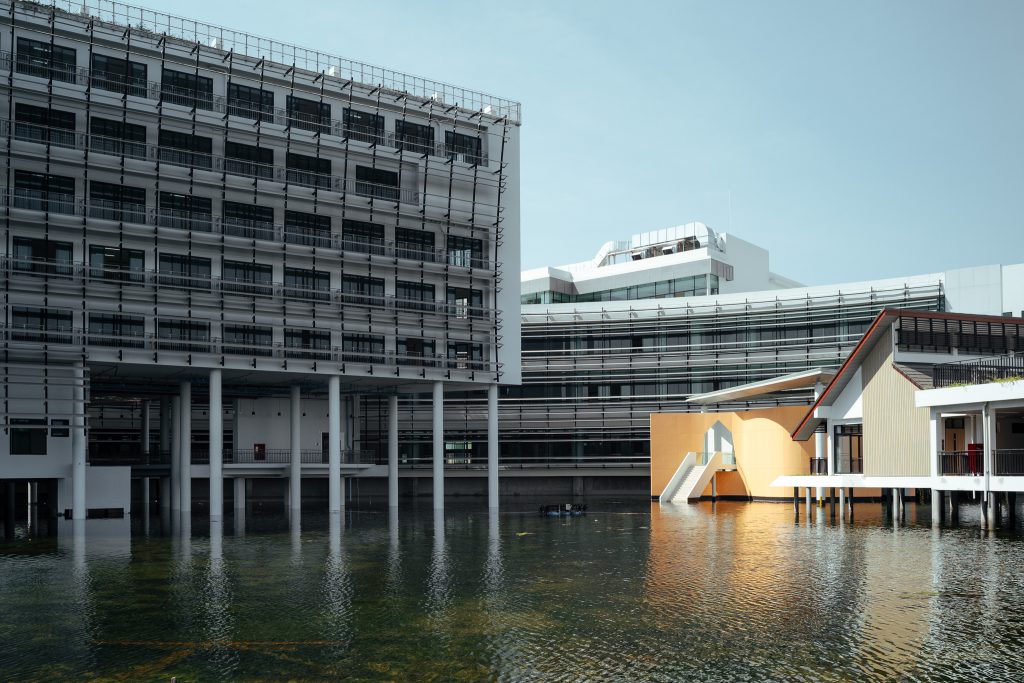This 150,000-square meter healthcare facility is an attempt from Bangkok Metropolitan Administration to provide social welfare and well-being for the elderly.
Text: Kraipol Jayanetra
Photo: Peerapat Wimolrungkarat
Download the online journal Issue 01 The ComfortZone Click here
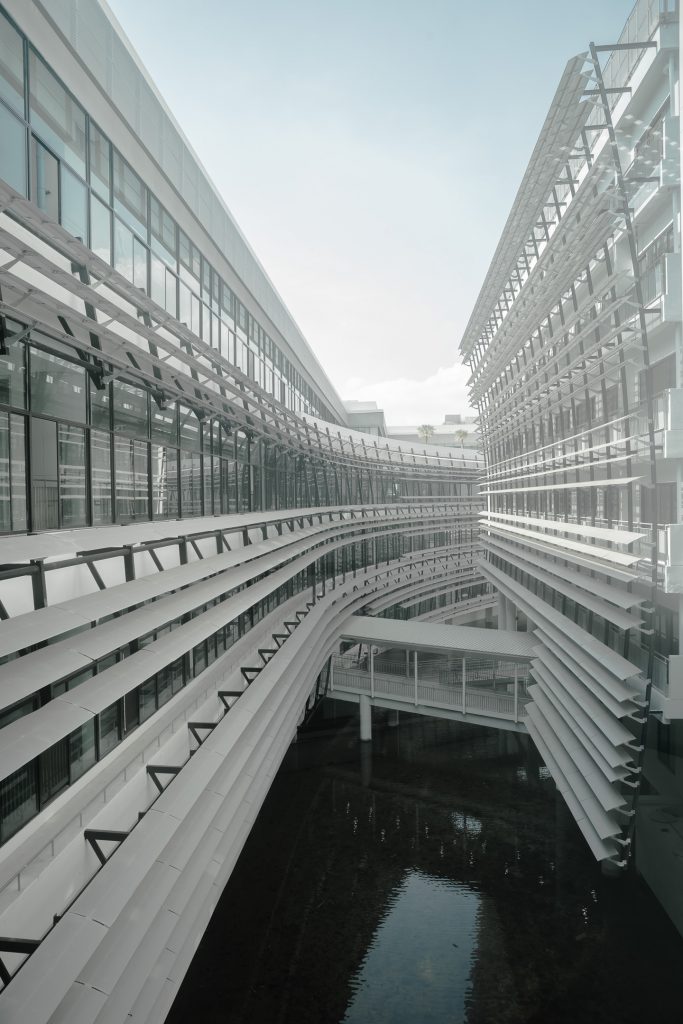
ดูกลมกลืนกันมากขึ้น
Photo: Peerapat Wimolrungkarat
อย่างที่ทราบกันดีว่าประเทศไทยกำลังเปลี่ยนผ่านเข้าสู่สังคมผู้สูงอายุโดยสมบูรณ์ (Aged Society) ในปี 2564 นี้ การเตรียมพร้อมระบบสาธารณูปโภคเพื่อรองรับและจัดการคุณภาพชีวิตให้กับผู้สูงอายุที่มีปริมาณเพิ่มขึ้นได้กลายเป็นประเด็นที่สังคมให้ความสนใจและกังวล ดังที่เห็นได้จากปรากฏการณ์ที่ภาคเอกชนได้เร่งดำเนินการผลิตโครงการอสังหาริมทรัพย์ที่เน้นกลุ่มเป้าหมายเป็นผู้สูงวัยที่มีรายได้สูงเป็นจำนวนมากในปัจจุบัน คำถามที่สำคัญที่ตามมาคือแล้วผู้สูงวัยทั่วไปที่มีรายได้ไม่สูง และไม่สามารถเข้าถึงโครงการของภาคเอกชนได้ จะสามารถจัดการดูแล สุขภาพ และคุณภาพชีวิตของพวกเขาเองได้อย่างไร จากคำถามข้างต้นเพื่อจัดการสุขอนามัยของ ผู้สูงวัย ซึ่งเป็นหนึ่งในประเด็นทางยุทธศาสตร์ของแผนพัฒนากรุงเทพมหานครระยะ 20 ปี โดยหม่อมราชวงศ์ สุขุมพันธุ์ บริพัตร ผู้ว่าราชการกรุงเทพมหานครในสมัยนั้นได้มอบหมายให้บริษัทออกแบบสถาปัตยกรรม 3 บริษัท ประกอบด้วย บริษัทสถาปนิกหนึ่งร้อยสิบ บริษัทสถาปนิกทรีดี และบริษัทไดแมซิอันสตูดิโอ ร่วมกันออกแบบโรงพยาบาลผู้สูงอายุบางขุนเทียน ในปี 2554 เพื่อรองรับผู้ป่วยในพื้นที่ทางตอนใต้ของกรุงเทพฯ
พื้นที่สัญจรภายในอาคารโรงพยาบาล
Photo: Peerapat Wimolrungkaratพื้นที่ภายนอกอาคารโรงพยาบาล 1
อาคารPhoto: Peerapat Wimolrungkaratพื้นที่ภายนอกอาคารโรงพยาบาล 2
Photo: Peerapat Wimolrungkaratบรรยากาศทางสัญจรในอาคาร
Photo: Peerapat Wimolrungkarat
ถึงแม้ว่าโรงพยาบาลผู้สูงอายุบางขุนเทียนได้เปิดให้บริการในอาคารชั่วคราวขนาดเล็กมาตั้งแต่ปี 2555 ทางกรุงเทพมหานครได้ใช้ เวลาจัดสรรงบประมาณ และทำการก่อสร้างเกือบเก้าปีในที่สุดโรงพยาบาลรัฐขนาด 300+100 เตียง สำหรับผู้ป่วยทั่วไปและ 34 เตียง สำหรับผู้สูงอายุที่มีพื้นที่ใช้สอยขนาดใหญ่ถึง 150,000 ตารางเมตร ก็มีโอกาสเปิดให้ใช้งานเป็นครั้งแรกโดยเป็นส่วนหนึ่งของโรงพยาบาลสนามเพื่อรองรับผู้ป่วย COVID-19 ตั้งแต่กลางปี 2563 ถึงแม้ว่าโรงพยาบาลแห่งนี้ยังไม่ได้เปิดให้บริการกับประชาชนอย่างเต็มรูปแบบ แต่ด้วยสภาวะที่สังคมตื่นรู้ถึงความสำคัญของโครงสร้างรัฐสวัสดิการจึงนำมาสู่การสำรวจงานออกแบบทั้งในเชิงนโยบายและการใช้งานทางสถาปัตยกรรมตามเจตนาในการริเริ่มโครงการเมื่อเกือบสิบปีที่แล้วว่าจะสอดคล้องหรือจุดประเด็นคำถามในการจัดการภาคปฏิบัติของรัฐว่าเป็นอย่างไร โครงการโรงพยาบาลผู้สูงอายุบางขุนเทียนมีจุดเริ่มต้นจากการที่ชาวบ้านตายายคู่หนึ่งได้บริจาคที่ดินเปล่าขนาด 50 ไร่ ในพื้นที่ราบลุ่มป่าชายเลนให้ทางกรุงเทพมหานครไปใช้ สำหรับงานทางด้านสาธารณสุขถึงแม้ว่าทิวทัศน์โดยรอบของที่ดินผืนนี้จะสวยงาม เหมาะแก่การใช้เป็นสถานที่พักฟื้นแต่ที่ดินผืนนี้ก็อยู่ห่างจากถนนหลักอย่างถนนพระราม 2 ไปถึง 10 กิโลเมตร
เปลือกโลหะเจาะรูของอาคาร
Photo: Peerapat Wimolrungkaratบริเวณรับส่งด้านหนึ่งของอาคาร
Photo: Peerapat Wimolrungkaratเปลือกอาคารของพื้นที่รับส่งมุมสูง
Photo: Peerapat Wimolrungkarat
พื้นที่ดั้งเดิมตั้งอยู่ในระดับที่ต่ำกว่าถนนบางขุนเทียนชายทะเล ซ้ำด้านหลังของผืนที่ดินยังติดกับคลองสาธารณะ ที่ใช้เป็นทางลำเรียงถ่ายมวลน้ำของพื้นที่ลุ่มที่อยู่ระหว่างแม่น้ำท่าจีนและแม่น้ำเจ้าพระยาไปลงอ่าวไทย ทำให้ผืนที่ดินแห่งนี้มีน้ำขังและอยู่ในสภาพเตรียมรับมือน้ำท่วมตลอดเวลา จากสภาพบริบทข้างต้น แทนที่ทางกรุงเทพมหานครจะเลือกทำโครงการนี้ให้เป็นโครงการขนาดเล็กที่เน้นเฉพาะเรื่องการดูแลพักฟื้นผู้สุงอายุ เพื่อลดความเสี่ยงในการสร้างงานสถาปัตยกรรมที่กระทบระบบนิเวศทางเดินน้ำของชุมชนรอบๆ กรุงเทพมหานครกลับเลือกที่จะลงทุนถึง 2,400 ล้านบาทในการสร้างโรงพยาบาลขนาดใหญ่ที่เปิดให้บริการทั้งผู้สูงอายุและคนไข้ทั่วไป
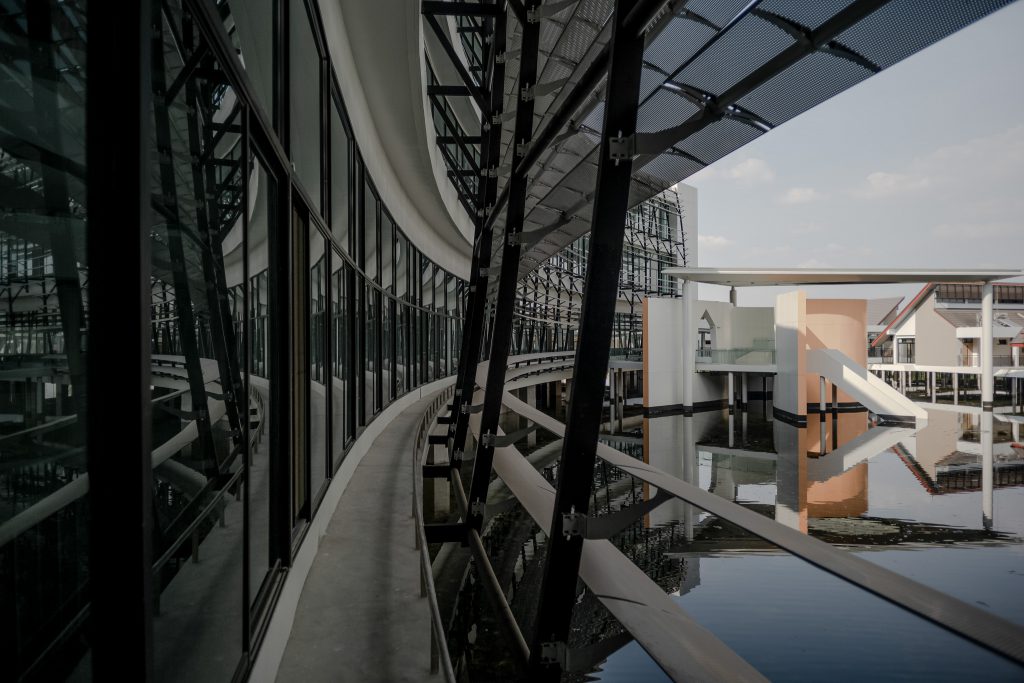
Photo: Peerapat Wimolrungkarat
ดังนั้นเพื่อให้ทีมออกแบบทั้งสามบริษัทสามารถจัดการการออกแบบโดยที่มีขนาดใหญ่ ซับซ้อน และยังมีบริบททางธรรมชาติที่แปลกไปจากโรงพยาบาลทั่วๆไป แนวคิดในการออกแบบผ่านการวางผังโครงการเพื่อรักษาสมดุลระหว่างงานสถาปัตยกรรมและธรรมชาติ ความสมดุลในการใช้โรงพยาบาลระหว่างผู้สูงอายุกับผู้ป่วยทั่วไป หรือระหว่างผู้ป่วยรายวันกับผู้ป่วยพักฟื้นและความสมดุลในการแบ่งเนื้องานระหว่างสามบริษัทในการออกแบบ จึงกลายเป็นประเด็นสำคัญที่ทีมสถาปนิกต้องจัดการการออกแบบให้อาคารขนาดใหญ่พิเศษสามารถ อยู่ในพื้นที่ราบลุ่มป่าชายเลนโดยที่สถาปัตยกรรมนั้น ไม่รบกวนระบบนิเวศทางน้ำของพื้นที่รอบๆ ทีมสถาปนิกมองว่าแนวคิดการงานสถาปัตยกรรมให้แนบชิดใกล้น้ำจะกลายเป็นโอกาสมากกว่าปัญหา จึงเกิดแนวคิดที่ทีมผู้ออกแบบได้แบ่งที่ดินรูปสี่เหลี่ยมคางหมู โดยการขีดเส้นโค้งพาดผ่านพื้นที่โครงการเป็นแนวทแยงมุมแล้วเลือกที่จะขุดดินด้านที่ติดคลองให้เป็นแก้มลิง และนำดินที่ขุดไปถมที่ดินด้านติดถนนเกิดเป็นการแบ่งพื้นที่ส่วนบนดินและส่วนในน้ำวางตำแหน่งกลุ่มอาคารโรงพยาบาลทั่วไปที่เน้นการเข้าถึงได้สะดวกรวดเร็วสำาหรับ ผู้ป่วยรายวันไว้บนฝั่งถมดิน และวางพื้นที่ส่วนอาคารที่ใช้รองรับการรักษาระยะยาวอย่าง อาคารหอพัก ผู้ป่วยทั่วไป และอาคารพักฟื้น ผู้สูงอายุไว้ลอยเหนือน้ำทางด้านหลังการรักษาสมดุลในการบริหารงานออกแบบทีมสถาปนิกได้แบ่งหน้าที่โดยบริษัทสถาปนิกหนึ่งร้อยสิบจัดการออกแบบอาคารโรงพยาบาลทั่วไป บริษัทสถาปนิกทรีดีดูแลการออกแบบอาคารพักฟื้นผู้สูงอายุ ส่วนทางบริษัทไดแมซิอัน สตูดิโอ รับผิดชอบออกแบบอาคารหอพักทั่วไป หอพระ และออกแบบหน้ากากที่โอบรัดอาคารโรงพยาบาลและหอพักเพื่อสร้างบรรยากาศที่กลมกลืนกัน
บรรยากาศพื้นที่สัญจรภายในอาคาร 1
Photo: Peerapat Wimolrungkaratบรรยากาศพื้นที่สัญจรภายในอาคาร 2
Photo: Peerapat Wimolrungkaratบรรยากาศพื้นที่สัญจรภายในอาคาร 3
Photo: Peerapat Wimolrungkaratบรรยากาศพื้นที่สัญจรภายในอาคาร 4
Photo: Peerapat Wimolrungkarat
สำหรับรายละเอียดของการออกแบบอาคารโรงพยาบาลทั่วไปที่มีขนาดความยาวถึง 320 เมตร และมีความหนาอาคารถึง 60 เมตร เพื่อลดความอึดอัดของมวลอาคารทีมสถาปนิกได้ซอยแบ่งพื้นที่ปฏิบัติการ เช่น ห้องตรวจต่างๆ ห้องจ่ายยา ห้องผ้าตัดและ ห้องไอซียูออกเป็นกลุ่มก้อนย่อยหกกลุ่มวางในแนวดิ่งส่วนพื้นที่ว่างระหว่างกลุ่มก้อนนั้นถูกเจาะให้เป็นคอร์ทยาร์ดที่นำแสงธรรมชาติเข้ามาและใช้เป็นจุดพักคอยหรือสวนหย่อมที่ว่างเหล่านี้ยังเชื่อมต่อกับทางเดินตามแนวโค้งที่วิ่งอยู่ตามแนวขอบของอาคาร เกิดเป็นพื้นที่โล่งรูปทรงคล้ายนิ้วมือสี่นิ้วที่ทำหน้าที่ถ่ายเททั้งอากาศ และผู้ใช้งานระหว่างกลุ่มอาคารสำหรับอาคารที่ปลีกตัวลอยอยู่ เหนือบ่อน้ำอย่างอาคารหอพักผู้ป่วยทั่วไปที่มีรูปทรงอาคารดูหวือหวาเป็นมุมแหลม มุมป้าน ซึ่งดูแล้วอาจจัดแบ่งเป็นพื้นที่ใช้สอยประเภทห้องได้ยากแต่การเกิดรูปทรงเหล่านี้เป็นผลมาจากการจัดวางความสัมพันธ์ของที่ว่างระหว่างอาคาร
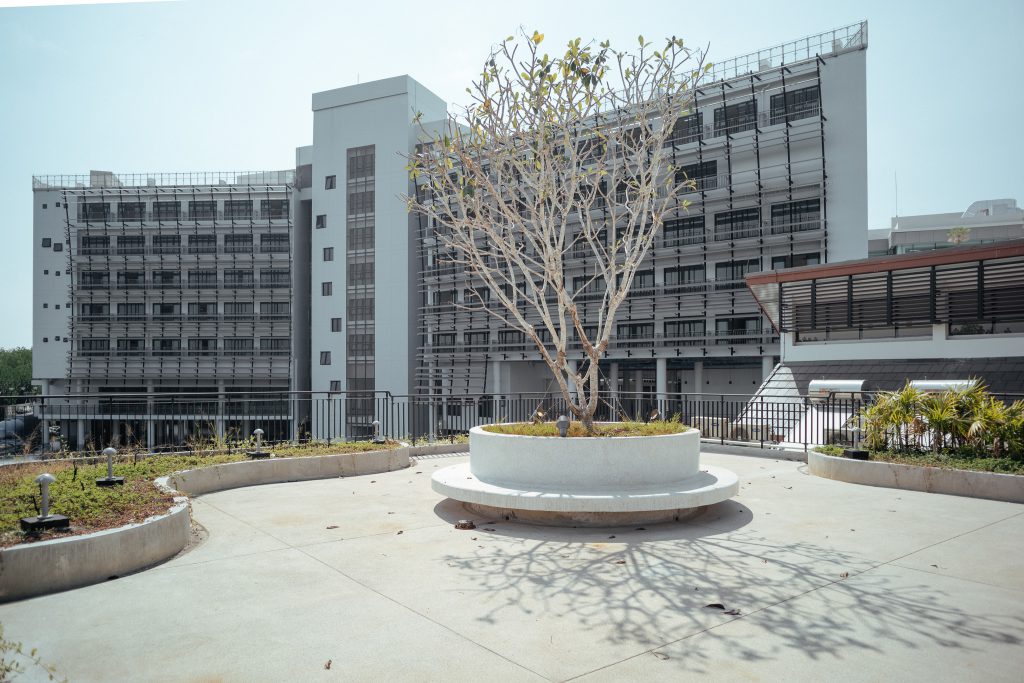
Photo: Peerapat Wimolrungkarat
กล่าวคือ ถ้าเรากลับไปดูมุมมองการเดินเข้าอาคารจากจุด drop off หลักของอาคารโรงพยาบาล เราจะพบกับที่ว่างขนาดใหญ่อยู่ตรงมุมหัวโค้งที่ว่างตำแหน่งนี้เปรียบเสมือนเป็นใจของอาคารในการถ่ายเทหมุนเวียนผู้ใช้งานไปในจุดต่างๆ ดังนั้นเพื่อให้เกิดความชัดเจนของแกนอาคาร ทางทีมสถาปนิกจึงตั้งใจถอยร่นแนวหอพักออกมาเพื่อให้เกิดที่ว่างเหนือน้ำให้ผู้ใช้งานไม่รู้สึกอึดอัด และสามารถมองเห็นคูน้ำโดยรอบจากส่วนใจของอาคาร อย่างไรก็ดีเนื่องจากแนวเขตที่ดินทางทิศตะวันออกนั้นเป็นมุมแหลมกับอาคารโรงพยาบาล หากออกแบบ อาคารหอพักผู้ป่วยในให้เป็นอาคารมุมฉากทั่วๆไป จะกลายเป็นว่าอาคารหลังนี้มีขนาดอาคารที่เล็กลงซึ่งจะส่งผลให้หอพักผู้ป่วยในต้องเพิ่มขยายจำนวนชั้นเพิ่มจำนวนห้องและจำนวนของพยาบาลในการดูแลผู้ป่วยไปโดยปริยาย นอกจากนั้นหากเราพินิจการจัดวางห้องภายในหอพักนี้ดีๆ อาคารที่มีผังคล้ายกับรูปทรงปีกผีเสื้อหลังนี้จริงๆ แล้วมีพื้นที่การจัดผังในรูปแบบปกติของการจัดวางแบบคอร์ทยาร์ด โดยพื้นที่รอบนอกอาคารถูกแบ่งให้เป็นห้องพักของผู้ป่วยทั้งเตียงเดี่ยวและเตียงรวมและพื้นที่ตรงกลางนั้นถูกออกแบบเป็นจุดรวม ของพยาบาลที่สะดวกต่อการควบคุมและดูแลห้องพักผู้ป่วยโดยรอบ
บันไดภายนอกเชื่อมต่อระหว่างปีกของอาคาร
Photo: Peerapat Wimolrungkaratบรรยากาศการเดินการของการเชื่อมต่อระหว่างปีกของอาคาร
Photo: Peerapat Wimolrungkarat
ส่วนอาคารที่พักผู้สูงอายุนั้นผู้ออกแบบวางตำแหน่งไว้บริเวณทิศเหนือของโครงการด้วยลักษณะพื้นที่ที่ไม่ใหญ่โต แต่ดูเป็นสัดส่วนปลีกวิเวกออกมาจากส่วนอื่นของโครงการและยังหันหน้าออกไปรับวิวท้องน้ำธรรมชาติทางด้านหลังของโครงการด้วยความที่โปรแกรมห้องพักฟื้น ผู้สูงอายุนี้จะรองรับผู้ป่วยสูงวัยที่ต้องใช้ชีวิตอยู่ในโรงพยาบาลเป็นเวลานาน ทีมสถาปนิกจึงพยายามออกแบบกลุ่มอาคารหลังนี้ให้เป็นกลุ่มก้อนเล็กๆ หลายๆ กลุ่มกระจายตัวอยู่บนผืนน้ำและเชื่อมต่อกันด้วยแนวทางเดินโดยที่อาคารแต่ละหลังจะเป็นอาคารชั้นเดียวหลังคา ทรงจั่วที่มีชายคายื่นออกมารับระเบียงดูคล้ายกับเรือนแพ เนื่องจากโครงการนี้ถูกพัฒนาโดยบริษัทสถาปนิกสามบริษัท เมื่อเรานำอาคารทั้งสามมารวมตัวกันในผังโครงการแล้ว เราสามารถเห็นร่องรอยความเป็นปัจเจกแตกต่างที่คล้ายกับงานศิลปะจัดวาง ดังนั้นเพื่อที่จะรักษาสมดุลไม่ให้อาคารเหล่านี้รู้สึกดูขัดแย้ง และแปลกแยกจนเกิดไป ทีมสถาปนิกจึงเลือกที่จะคุมโทนสีอาคารทั้งหมดด้วยเฉดสีขาวสว่าง สะอาดตา และเลือกใช้บานเกล็ดอลูมิเนียมมาบังแนวผนังอาคารโรงพยาบาลทางด้านผนังโค้งและผนังรอบๆส่วนหอพัก เพื่อช่วยในการกรองแสง ธรรมชาติ และทำให้อาคารสองหลังนี้มีหน้าตาที่คล้ายกันขึ้น อย่างไรก็ดีสิ่งที่ช่วยให้โครงการนี้ ดูลงตัวขึ้นกลับกลายเป็นการมีอยู่ของหอพระอาคารผนังสีส้มพาสเทลรูปทรงประหลาดคล้าย กับงานประติมากรรมที่ตั้งลอยอยู่เหนือน้ำสามารถสร้างภาพคอนทราสที่ดึงดูดความสนใจจนทำให้เราละสายตาไม่จับจดอยู่กับความแตกต่างของอาคารหลังอื่น การใช้องค์ประกอบขนาดเล็กที่มีรูปทรงดูเหนือจริงแต่ก็ไม่ได้มีภาพในเชิงสัญลักษณ์ทางศาสนาที่ชัดเจน สามารถเติมความรู้สึกทางจิตวิญญาณ และลดทอนบรรยากาศขึงขังเย็นชาที่เรามักพบเห็นในโรงพยาบาลทั่วๆ ไปได้เป็นอย่างดี
การเจาะช่องแสงธรรมชาติลงมาภายในอาคาร
Photo: Peerapat Wimolrungkaratบริเวณที่เจาะช่องแสงและแสดงทางเชื่อมระหว่างอาคาร
Photo: Peerapat Wimolrungkarat
ถ้าหากมองภาพมุมการบริหารนโยบายจากบนลงล่าง (Top down) การจัดการออกแบบโดยภาครัฐในโครงการนี้นับว่าสามารถทำได้ดี ตอบสนองต่อการเปลี่ยนแปลงของสังคม และยังสามารถสร้างภาพลักษณ์องค์กรให้ดูมีความทันสมัย สะอาด โปร่งใสขึ้น อย่างไรก็ดีหากเราก้าวข้ามภาพรวมขนาดใหญ่ และตั้งคำถามจากระดับล่าง (Bottom up) ขึ้นไปบ้าง เราอาจจะมีคำถามเกี่ยวกับโครงการนี้อีกมากมาย อาทิ การสร้างโรงพยาบาลขนาดใหญ่ที่มีความยากลำบากในการเข้าถึงโดยระบบขนส่งมวลชนนั้นจะมีประสิทธิภาพดีกว่าการสร้างศูนย์พยาบาลขนาดเล็กที่กระจายตัวไปอยู่ในเขตชุมชน หลายๆ แห่งจริงหรือไม่การสร้างโรงพยาบาลที่มีบริบทเฉพาะตัวจะสามารถใช้เป็นต้นแบบในการพัฒนาโรงพยาบาลสำหรับผู้สูงอายุในที่อื่นได้อีกหรือไม่ การลงทุนมหาศาลในครั้งนี้จะส่งผลให้กรุงเทพมหานครไม่สามารถกระจายทุนไปพัฒนาโครงการสำหรับผู้สูงอายุในที่อื่นๆ ได้หรือไม่ โรงพยาบาลที่เป็นลูกผสมนั้นสามารถจัดการดูแลผู้สูงอายุได้มีประสิทธิภาพกว่าการสร้างศูนย์ดูแลเฉพาะทางหรือไม่ วิธีการสร้างอาคารบนน้ำจะไม่สร้างปัญหาต่อตัวอาคาร และระบบนิเวศทางน้ำหรือไม่ แน่นอนว่าเราคงไม่สามารถตอบคำถามเหล่านี้ได้ในช่วงระยะเวลาอันใกล้นี้ แต่ด้วยสภาวะที่สังคมตื่นรู้ถึง ความสำคัญของโครงสร้างของรัฐสวัสดิการ เราควรจะเริ่มสอดส่องดูแลและใส่ใจถึงเรื่องเหล่านี้ เพื่อเป็นการรักษาสิทธิ์ในการเข้าถึงความสบายใจที่รัฐมีพันธะต้องมอบให้กับเราต่อไปในอนาคต
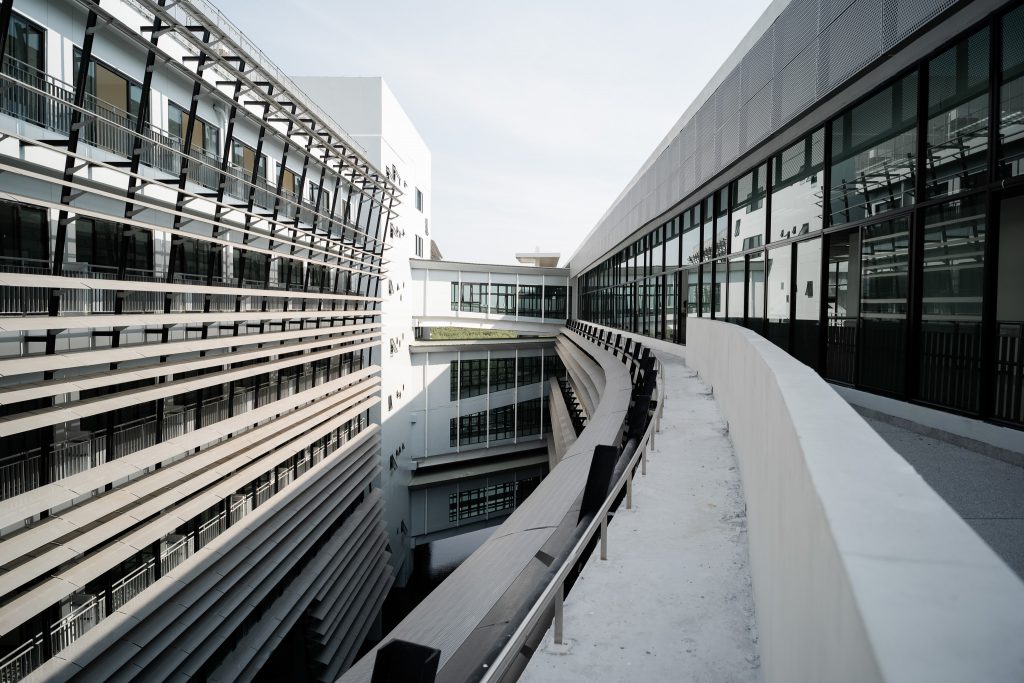
Photo: Peerapat Wimolrungkarat
The state-run hospital is equipped with 300+100 beds for regular patients and 34 beds for elderly patients within the expanse of a 150,000-square meter functional program.
We have been made aware of the fact that Thailand will become an aged society in 2021. The preparation of public utilities to accommodate and manage a good living standard for the country’s growing number of senior citizens has been an issue that society is both interested in and concerned about. One of the solutions that have come from the private sector is the rise of real estate development projects that target the elderly with high income. The critical question that follows is what about the middle and lower-income senior citizens who cannot access the privately-run facilities? How can they look after their own well-being and sustain a standard quality of life by themselves? From the questions mentioned above, one of the attempts to manage the well-being of the senior citizens was initiated as a part of the Bangkok Metropolitan Administration’s 20-year development plan by the Governor at the time, MR Sukhumbhand Paribatra. The initiative led to the birth of Bangkunthian Geriatric Hospital, where three architecture firms, Architects 110, 3D Architects, and Dymaxion Studio were assigned to co-design Bangkunthian Geriatric Hospital, provide services for the patients who reside in southern Bangkok and around the vicinity.
บริเวณที่จอดรถภายนอกอาคารโรงพยาบาล
Photo: Peerapat Wimolrungkaratมุมมองระยะใกล้ของเปลือกอาคารที่เจาะช่องโลหะ
Photo: Peerapat Wimolrungkaratบรรยากาศพื้นผิวเปลือกอาคาร
Photo: Peerapat Wimolrungkaratบริเวณด้านหน้าอาคารโรงพยาบาล กรุผิวภายนอกด้วยโลหะเจาะรูหลากหลายขนาด
Photo: Peerapat Wimolrungkarat
Bangkunthian Geriatric Hospital was previously operating in a small, temporary building since 2012 before Bangkok Metropolitan Administration (BMA) spent almost nine years allocating their budget and finishing the construction. The state-run hospital is equipped with 300+100 beds for regular patients and 34 beds for elderly patients within the expanse of a 150,000-square meter functional program. It currently operates officially as a designated field hospital, accommodating COVID-19 patients since mid-2020. Although the hospital has not yet fully opened, the growing awareness of the importance of welfare state structure had led to a deeper look into many aspects of the design. This article will explore the policy-making taken behind the project when it was initiated almost a decade ago, particularly how it resulted in the functions of architectural features, and whether they have been in tune with or raise questions regarding the management and implementation by the government sector.
การเจาะช่องแสงภายในอาคาร 1
Photo: Peerapat Wimolrungkaratแนวบานเกล็ดของอาคาร
Photo: Peerapat Wimolrungkaratการเจาะช่องแสงภายในอาคาร 2
Photo: Peerapat Wimolrungkarat
Bangkunthian Geriatric Hospital originated from a couple of grandparents who donated a 19.7-acre lot of land to the BMA to develop a healthcare-related project. Home to a mangrove forest, the land is surrounded by a beautiful environment, making it an ideal site for a rehabilitation facility despite being 10 kilometers away from the main road (Rama 2 Road). The land’s original ground level was lower than Bangkhunthein Chaitalay road, while the back of the property is adjacent to a public canal whose primary role is to transport the mass of water pro- duced by the plains stretching between Tha Jin and Chaopraya River into the Thai Gulf. With such geographical background, it causes the land to be saturated and ready to accommodate a flood. Despite this being the surrounding geographical context, the BMA decided against making the pro- ject a small hospital that focuses solely on elderly care and patients to reduce the risks of building an architectural structure that could potentially disrupt the Ecosystem of the waterways. Instead, it proceeded to invest over THB 2.4 billion in building a large-scale hospital that caters to both regular and elderly patients.
การควบคุมวัสดุและสีของกลุ่มอาคารที่แตกต่างกันให้ดูกลมกลืนกันมากที่สุด
Photo: Peerapat Wimolrungkaratบริเวณทางเชื่อมภายในอาคารหอพระ
Photo: Peerapat Wimolrungkarat
The three assigned design firms faced the challenge of efficiently and successfully handling a large-scale and complex project. In addition, the site’s surrounding environment is relatively unconventional compared to most hospitals. Therefore, the design concept developed from the master plan focuses on maintaining the balance; whether between architecture and nature, elderly patients and regular patients, outpatients and admitted patients, including the distribution of tasks and responsibilities among the three design firms. Having to design an extra-large built structure on a saturated plain surrounded by mangrove forests and mitigate any possible disturbances the architecture might bring to the neighboring waterways, the architects agreed that having a site near the water should be considered as an opportunity rather than a dilemma. The design teams decided to divide the trapezoidal land with a curved line that cut across the property diagonally.

Photo: Peerapat Wimolrungkarat
The part of the land that is adjacent to the canal is dug into a water basin. The excavated earth was used to fill the section of the land adjacent to the main road. The approach automatically divided the property into dry and saturated land while the cluster of hospital buildings is located based on their accessibility. The segment that would accommodate daily access of outpatients situated on the dry land, while the facilities used to accommodate patients with long-term stays, such as the inpatient hall and elderly patient rehabilitation ward, are constructed near the water towards the back of the land. The tasks were divided effectively and managed with Architects 110 overseeing the general hospital building and 3D Architects in charge of the elderly rehabilitation building. Dymaxion Studio was responsible for the inpatient ward building, the Buddha Hall and the façade, which would help keep all the structures in the project under a unanimous mood and tone.
บรรยากาศภายในพื้นที่อาคาร 1
Photo: Peerapat Wimolrungkaratบรรยากาศภายในพื้นที่อาคาร 2
Photo: Peerapat Wimolrungkaratบรรยากาศพื้นที่จอดรถภายนอกอาคาร
Photo: Peerapat Wimolrungkarat
The distinctive architectural form might seem like a challenge to the allocation of interior floor plans and rooms, it was developed from the relationship between the functional spaces in the buildings.
Some basic information about the project includes the design of the general hospital building, which bears an extra length of 320 meters and a depth of 60 meters. The dimension intends to lessen the confinement of the building’s mass and interiors. The architecture team divides the functional spaces such as examination rooms, the pharmacy unit, operation rooms, and ICU wards into six vertical subunits. The spaces between these units are carved into courtyards that bring natural light into the interior spaces and serve as resting points and small gardens. The negative spaces connect to the curved part of the walkways that run along the building’s periphery. The floor plan creates an open space with a shape similar to a hand with four spread out fingers. Functionally, the areas help with the building’s natural ventilation and connect users to other facilities within the cluster. The more isolated structure of the general inpatient ward built into the water basin sees a more visually striking appearance with sharp corners and wide angles. While the distinctive architectural form might seem like a challenge to the allocation of interior floor plans and rooms, it was developed from the relationship between the functional spaces in the buildings.
บรรยากาศภายนอกของบริเวณอาคารสถานพักฟื้นผู้สูงอายุ 1
Photo: Peerapat Wimolrungkaratบรรยากาศภายนอกของบริเวณอาคารสถานพักฟื้นผู้สูงอายุ 2
Photo: Peerapat Wimolrungkaratบรรยากาศภายนอกของบริเวณอาคารสถานพักฟื้นผู้สูงอายุ 3
Photo: Peerapat Wimolrungkaratบรรยากาศภายนอกของบริเวณอาคารสถานพักฟื้นผู้สูงอายุ 4
Photo: Peerapat Wimolrungkarat
To provide a better picture, when a user walks into the building from the main drop-off area, they will encounter the ample empty space situated at a corner of the functional program. The positioning creates a circulation that leads and distributes visitors to different parts of the program. The design team retreats the setback of the inpatient building to create an unoccupied space above the water, creating a visually and emotionally soothing perspective while enabling the surrounding waterways to be visually accessible right from the center of the program.
อาคารยกพื้นตั้งอยู่บนเสาลอย
เป็นองค์ประกอบร่วมกันอย่างหนึ่งของกลุ่มอาคารในโครงการนี้
Photo: Peerapat Wimolrungkaratมุมมองจากกลุ่มอาคารหอพักผู้ป่วยไปยังอาคารสถานพักฟื้นผู้สูงอายุ
Photo: Peerapat Wimolrungkaratบรรยากาศภายนอกของบันไดหอพระ
Photo: Peerapat Wimolrungkarat
Nevertheless, with the eastern periphery being a sharp corner, designing a hospital building with a regular right angle would create a smaller structure with less floor capacity. This would lead to the increase of floors, rooms, and nurses and staff needed to tend the patients. In addition, a closer look into the butterfly wing-shaped floor plan reveals a courtyard configuration in which the outer limit of the floor houses different types of patient rooms with the nurses’ operation counter placed at the center, allowing the staff to easily access and supervise the entire ward.
บรรยากาศระหว่าง 2 อาคารที่คล้อยตามกัน
Photo: Peerapat Wimolrungkaratอาคารหลักทั้งสี่ส่วน มองจากด้านอาคารหอพักผู้ป่วย
Photo: Peerapat Wimolrungkarat
As for the elderly patient building, the design positions the structure toward the north of the land. The mid-sized building is situated in a more private location, isolating itself from other parts of the project, facing natural water sources at the back of the project. The program of the elderly rehabilitation ward is designed to accommodate elderly patients who need to stay at the hospital for an extended period of time. The design team reconciled the functional spaces into small clusters of one-story structures built into the water and connected with a series of walkways. Each building is roofed with a gable structure, along with an eave protruding over the veranda, creating a raft house-like appearance.
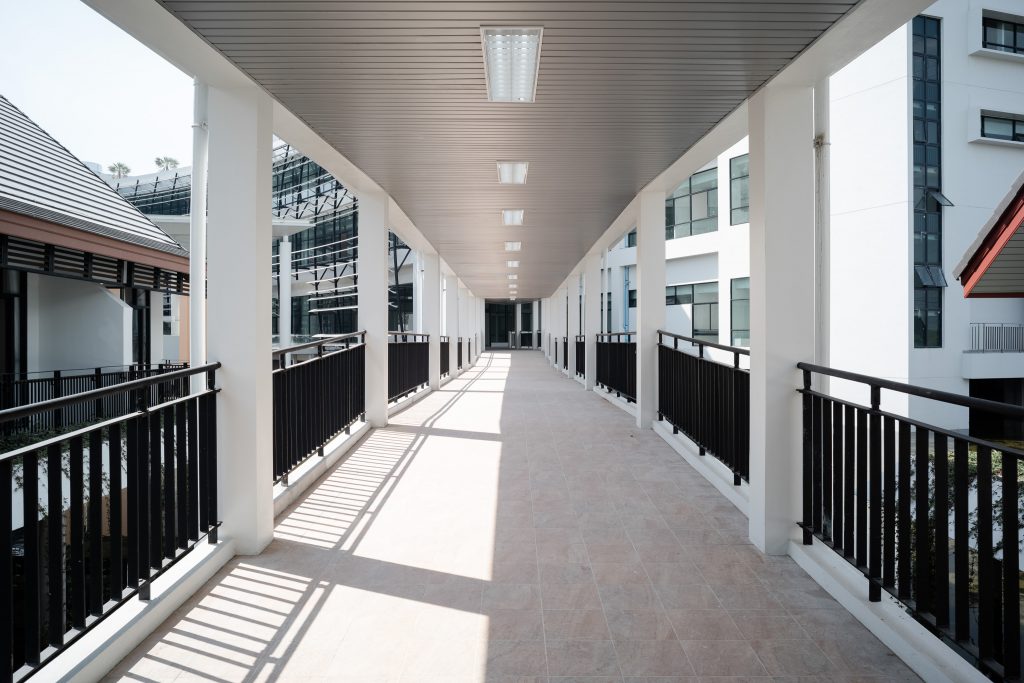
Photo: Peerapat Wimolrungkarat
Since the project’s design was developed by three companies, combining the three parts of the program into one unified site plan revealed traces of three individual design languages, similar to the clashing aesthetics of different installation art pieces. To keep everything balanced and minimize the contradiction and distinction, the design team decided to control the overall color tone using a clean, bright, white color. Aluminum louvers clad the hospital building’s curved walls and parts of the walls of the inpatient building, filtering natural light and providing the two buildings with a harmonious appearance.
พื้นที่บริเวณอาคารสถานพักฟื้นผู้สูงอายุ 1
Photo: Peerapat Wimolrungkaratพื้นที่บริเวณอาคารสถานพักฟื้นผู้สูงอายุ 2
Photo: Peerapat Wimolrungkaratพื้นที่บริเวณอาคารสถานพักฟื้นผู้สูงอายุ 3
Photo: Peerapat Wimolrungkarat
Nevertheless, the Buddha Hall is what keeps the project in the right balance. The pastel orange walls and the unusual-looking building create a sculpture-like form that appears as if it is floating on water. The jarring juxtaposition draws attention, as one could be easily distracted and captivated by the hall’s appearance and may lose focus on the differences of other buildings in the program. Small scales and compositions of the surreal form may not be an apparent religious representation, yet, collectively, they create a structure that radiates a spiritually fulfilling energy and tones down the rigidity and indifference usually found in hospital spaces in an interesting and beautifully depicted manner. If we were to look at the project from the top-down execution from which it’s originated and executed, the design is undeniably impressive considering that it’s a government-run project. It’s visually pleasing and resonates with the current and future social phenomenon, while simultaneously keeping the organization’s image and identity modern, clean and transparent.
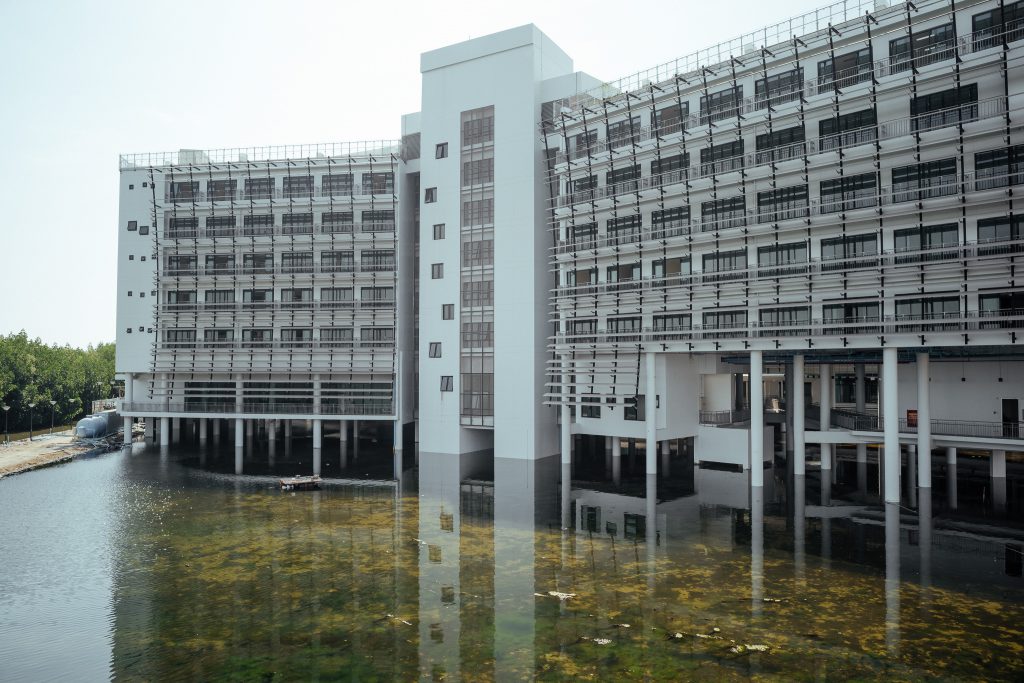
Photo: Peerapat Wimolrungkarat
If we were to look beyond the big picture and question the project from the bottom-up approach, many doubts would arise about why a hospital of such a large scale was built in a place where access by public transportation is challenging instead of distributing the budget to set up more but smaller healthcare facilities in different communities. We cannot help but wonder if a hospital of such a specific context can genuinely be the model of the development of other geriatric hospitals elsewhere in the future and whether this massive investment will end up obstructing the BMA from squeezing and distributing more of their budget towards other elderly-related projects. Then there’s a question about whether such a hybrid hospital can provide more efficient elderly care services than a health- care facility with specific expertise. There’s also a question concerning possible future problems with the built structures and the water ecosystem, considering the fact that the buildings are constructed right above the water. Indeed, we won’t be able to have all the answers to these questions soon. But with a society that is currently more aware of the importance of welfare state structure, these issues need to be highlighted and questioned, for as citizens, we need to preserve the right to access such transparency, which is something the state is and will be obligated to provide.


